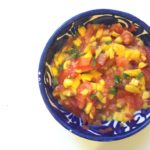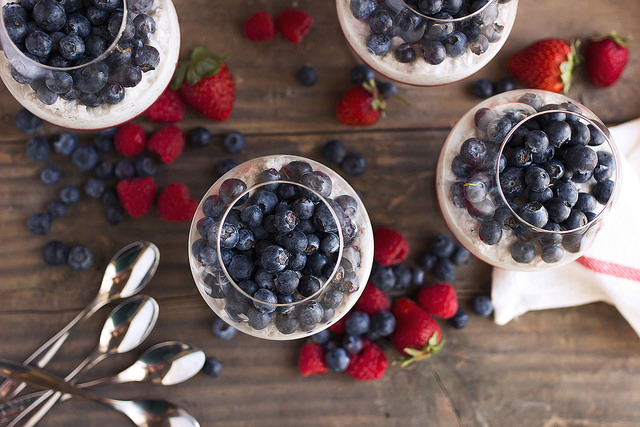Patriotic Red White and Blue Produce- Eat More!
This week it’s all about the Fourth of July! It’s a fun holiday filled with games, friends and/or family, and lots of patriotic red, white and blue foods. Red, white and blue foods can both be super healthy and also a bit less healthy, depending on how much extra and added artificial colors, flavors and other things are present in the foods. For many of us, eating less healthfully can feel like it’s a given on a holiday like July 4th, but with some care and thought, it doesn’t have to be!
When planning your patriotic red, white and blue foods to serve on the Fourth, don’t forget to plan to bring the original red, white, and blue foods — the fruits and vegetables! Red, white and blue fruits and vegetables are tasty, lower in sugar and calories, and higher in filling fiber to help fill you up. Additionally, fruits and vegetables that are red, white and blue are loaded with tons of nutrients that can help your body get healthy, boost your immune system and keep your weight in check.
Sounds pretty good right? Let’s talk red, white and blue produce and what nutrients they’re packing.
Red Produce
Red produce like cherries, beets, tomatoes, watermelon and others, are packed with healthy nutrients including:
- Anthocyanin: Anthocyanin is a nutrient that is found in richly-pigmented red and purple produce. Anthocyanin is incredibly powerful and helps to battle inflammation in the body – specifically in the blood vessels and heart. As a general rule of thumb, the richer the color of the red produce, the more anthocyanin it contains.
- Lycopene: Lycopene is a type of carotenoid, and has antioxidant properties and may be beneficial in helping prevent certain types of cancer like prostate, colon and lung cancer. Lycopene is found in the highest quantities in cooked tomatoes.
- Beta carotene: Beta carotene is also member of the carotenoid family and is a rich source of vitamin A that is key for immune and eye health; beta carotene may also help to reduce symptoms of exercise-induced asthma, age-related macular degeneration, and may also play a role in boosting mood, preventing certain types of cancers and more.
- Vitamin C: Vitamin C is a key nutrient for many reasons in the body. Vitamin C acts as an antioxidant and can help with cellular repair in the body, and it’s also a precursor to collagen and therefore may play a role with anti-aging.
- Tannins: Tannins are found in cranberries and are a member of the polyphenol family. The polyphenol family is a family of nutrients that contain antioxidant properties helping to fight free-radical damage in our bodies, and may play a role in preventing and decreasing risk for certain cancers like esophageal. Tannins may have antibacterial and antifungal properties as well helping to fight off fungal and bacterial infections.
White Produce
We say all the time that the more color is better, but let’s not forget the color-less fruits and vegetables, because they’re absolutely loaded with nutrients as well! So when it comes to including colors of the rainbow, white should be one of those you should absolutely include, here’s why:
- Flavonoids: Flavonoids are a very large family of nutrients that are colorless and contain many antioxidant properties to help fight free radicals and inflammation, and boost immunity as well amongst other things.
- Sulfur compounds: These may help to increase production of liver detoxifying enzymes and may help the body to fight and repair free radicals (cauliflower)
- B-vitamins: B vitamins are known as the “energizing” vitamins because they are involved in producing energy in the body amongst other things. Some white fruits and vegetables contain b vitamins including niacin and riboflavin.
- Allicin: Allicin is found in garlic and leeks, allicin contains antibacterial and antiviral properties and also acts as a powerful antioxidant in the body. When preparing garlic, cut/chop/mash it then allow it to sit for 5-10 minutes to promote the nutritional benefits.
- Quercetin: Quercetin is a nutrient found in the skin of fruits like apples and pears, and it may help to fight free radicals in the body that over time may contribute to diseases like cancer. Quercetin may also help ease discomfort in arthritis and in some cases is used to improve athletic performance in endurance athletes.
- Potassium: Potassium is found in most fruits and vegetables and is an essential electrolyte for our bodies that plays a role in muscle contraction and relaxation and fluid balance. Heart healthy and helps with fluid balance as well. Red fruits and vegetables are a particularly good source of potassium, but there is also potassium in white fruits and vegetables too.
- Anthoxanthin: Anthoxanthins is a nutrient in the family of flavonoids and is found in white produce. Anthoxanthin has been touted for its potential ability to lower stroke risk, promote heart health, and help fight free radical damage in our bodies that over time can contribute to cancer risk.
Blue Produce
Blue fruits and vegetables aren’t only beautiful to look at, but they’re also packed with tons of nutrients that are disease fighting. Here’s a few nutrients that you’ll find in your blue fruits and vegetables this fourth of July:
- Anthocyanins: Anthocyanins are found in blue produce as in red produce, and they deserve to be mentioned twice because they’re just that fantastic! As previously mentioned there are packed with anti-inflammatory and antioxidant properties. They’re found in blueberries, blackberries and other blue/purple produce like purple cauliflower and eggplant.
- Resveratrol: You may have heard of resveratrol as the healthy nutrient found in wine. Well yes, it is found in wine, but it’s also found in small amounts in the skin of blueberries and grapes. Resveratrol has been found to be beneficial with promoting heart and blood vessel health. In such small quantities in berries and grapes it won’t pack a major punch, but it’s certainly present!
- Ellagic acid: Ellagic acid is part of the phenolic compound family and research suggests that it may be beneficial for a number of reasons, one of which involves free-radical fighting and cancer-prevention; some research suggests that ellagic acid specifically may be helpful in the prevention of prostate cancer. Ellagic acid that is found in berries (including red berries) may also help to benefit blood sugar metabolism by preventing carbohydrates from starches from entering the blood stream, although this research is still being investigated and developed.
- Vitamin C: Vitamin C that’s found in berries, is an antioxidant and definitely one you’ve heard of because of it’s long-touted benefits with boosting immune health. Vitamin C is also a well-known antioxidant and a precursor to collagen that affects skin health too.
Red, white and blue recipes to try:
Heart Healthy Blueberry Smoothie


*Most of this article was originally created for Reboot with Joe- click here for the original post.








